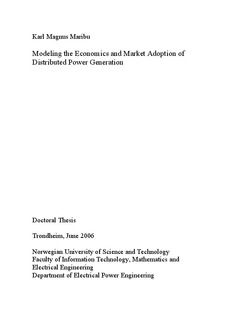| dc.description.abstract | After decades of power generating units increasing in size, there is currently a growing focus on distributed generation, power generation close to energy loads. Investments in large-scale units have been driven by economy of scale, but recent technological improvements on small generating plants have made it possible to exploit the benefits of local power generation to a larger extent than previously. Distributed generation can improve power system efficiency because heat can be recovered from thermal units to supply heat and thermally activated cooling, and because small-scale renewables have a promising end-user market. Further benefits of distributed generation include improved reliability, deferral of often controversial and costly grid investments and reduction of grid losses. The new appeal of small-scale power generation means that there is a need for new tools to analyze distributed generation, both from a system perspective and from the perspective of potential developers. In this thesis, the focus is on the value of power generation for end-users. The thesis identifies how an end-user can find optimal distributed generation systems and investment strategies under a variety of economic and regulatory scenarios. The final part of the thesis extends the analysis with a bottom-up model of how the economics of distributed generation for a representative set of building types can transfer to technology diffusion in a market.
Four separate research papers make up the thesis. In the first paper, Optimal Investment Strategies in Decentralized Renewable Power Generation under Uncertainty, a method for evaluation of investments in renewable power units under price uncertainty is presented. It is assumed the developer has a building with an electricity load and a renewable power resource. The case study compares a set of wind power systems with different capacity and finds that capacity depends on the electricity price and that there under uncertain prices can be a significant value in postponing investment until larger projects are profitable. In the second paper, Combined Heat and Power in Commercial Buildings: Investment and Risk Analysis, a Monte Carlo simulation program to find the value and risk characteristics of combined heat and power units is presented. Using historical price data to estimate price process parameters, it is shown that uncertain prices should not be a barrier for investment, since on-site generators can adapt to uncertain prices and reduce the total energy cost risks. In, Optimizing Distributed Generation Systems for Commercial Buildings, which uses a mixed integer linear program, distributed generation portfolios that maximize profitability are tailored to a building's energy load. Distributed generation with heat recovery and thermally activated cooling are found profitable in an office and a health care building, using current generator data and energy tariffs from California. With the fourth paper, Distributed Energy Resources Market Diffusion Model, the analysis is taken a step further to predict distributed generation market diffusion. Market penetration is assumed to depend on economic attractiveness and knowledge and trust in the technologies. A case study based on the U.S. commercial sector depicts a large market for reciprocating engines and microturbines, with the West and Northeast regions driving market diffusion. Technology research and outreach programs can speed up and change the path of capacity expansion.
The thesis presents three different models for analyzing investments in distributed generation, all of which have benefits and disadvantages. Choice of model depends on the specific application, but the different approaches can be used on the same problem to analyze it from different viewpoints. The cases in the thesis indicate that distributed generation can reduce expected energy costs while at the same time improve cost predictability. Further, the thesis identifies several important factors and potential barriers to distributed generation adoption. Analyzing distributed generation from the end-user perspective is important also for policy makers, because of the importance of estimating how the market will react to potential policy measures. The thesis shows that small-scale generating capacity has the potential to increase in the near future. Further research should increase the understanding of economic and environmental issues related to distributed generation, while policy makers should aim to construct and implement measures that make it attractive for end-users to invest in efficient local generating capacity. | nb_NO |
